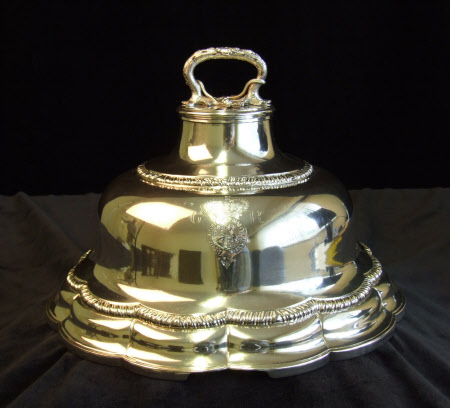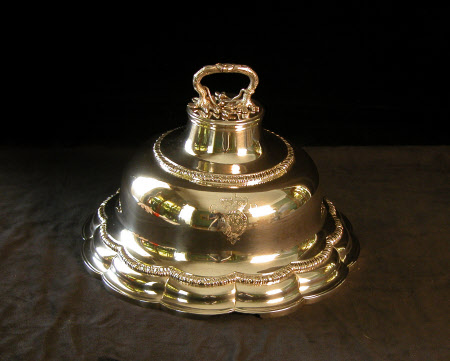Four round dish covers
Category
Silver
Date
circa 1758
Materials
Silver
Measurements
18.4 cm (Height); 27 cm (Diameter)
Order this imageCollection
Ickworth, Suffolk
NT 852121.1
Summary
Four round covers for dishes, silver, probably London, circa 1758. The round and lobed covers are raised and have stepped bases conforming to the set of larger round dishes (NT 852121.3.1-4). The bases terminate in a chased band of gadrooning and the covers rise as circular convex domes to another chased gadroon band, then rise again in reverse form to an applied flat top plate, the joint concealed by a cast and seemed moulding. The cast and chased tendril handles are capped by single flowers and held on by silver bolts and nuts. Heraldry: On the front of each cover are engraved the quartered arms of the Hanoverian monarchs (pre-1801) within the Garter and beneath an imperial crown flanked by the initials G R. Hallmarks: None. Scratchweights: ‘Nº- 1 = 33=0’; ‘No 2 = 35=0’; ‘No 3 = 34=3’; ‘No 4 = 34=6’
Full description
The Jewel Office allocation in 1758 lists twenty dish covers as being delivered for Lord Bristol’s use in 1758 and of these only the eight now at Ickworth survive.[1] The absent twelve, which had gone by 1811,[2] are unlikely to have been part of the scheme to extract money for the excessive fashion cost of other items (see NT 852077) as they would have had to be specifically made for the dishes and to have matched the covers that do survive. Thus they could not easily have been taken from stock and then passed on to other clients once they had served their illicit purpose. They must therefore have been exchanged or lost at some point thereafter, or have been removed to Ireland by the Earl-Bishop and passed to the Bruce family. As they would have had to account for 935 ounces of silver they would have been for the larger sizes of dishes. The covers would have been in place at the start of the meal and have been removed when the tureens were taken away to be replaced with the next set of principal dishes. In the painting of the coronation banquet of Joseph II as King of the Romans in Frankfurt in 1764,[3] all the subsidiary tables are shown with their dishes still covered whereas at the high table the Imperial couple have commenced their meal and two attendants are removing the covers and passing them to footmen. As dishes did not rest on the table in the same fashion for service à la russe the need for covers waned during the nineteenth century and many must have been turned in to be melted, making them rare today. They did still come into their own at breakfast, however, and one can be seen in use at Ickworth alongside dishes by Paul Storr in a photograph of c.1870. Silver dish-covers were never commonplace in the aristocratic household anyway and many families had some or all of them in silvered brass or copper, or even as mere pewter. William Strode, for instance, acquired a ‘Brass Dish Cover Silver’d’ from Wickes and Netherton in 1753 for £2 including engraving (the same thing in silver, assuming a weight of 30 oz., would have cost at least £12) and the vastly wealthy Sir Jacob Downing, 4th Bt, when equipping himself with a dinner service in 1750, had seventeen pewter covers with his twenty silver dishes.[4] Lord Bristol may well have been thus equipped previously and have used the opportunity of the ambassadorial allocation to upgrade. James Rothwell, Decorative Arts Curator February 2021 [Adapted from James Rothwell, Silver for Entertaining: The Ickworth Collection, London 2017, cat. 73, pp.160-1] Notes: [1] The National Archives, LC 9/48, Jewel Office Accounts and Receipts Book 1728-67, ff. 166-8. [2] Suffolk Record Office, 941/75/1, list of plate of the 5th Earl (later 1st Marquess) of Bristol 1811-29. [3] Studio of Martin II Mytens, Schloss Schönbrunn, Austria. [4] National Art Library, Garrard Ledgers, VAM 5 1750–4, f. 110 and VAM 3 1747-50, f. 57.
Provenance
Jewel Office; allocated to George Hervey, 2nd Earl of Bristol (1721-75) as Ambassador to Madrid 1758; discharged to Lord Bristol 9 April 1759; by descent to the 4th Marquess of Bristol (1863-1951); accepted by the Treasury in lieu of death duties in 1956 and transferred to the National Trust.
Credit line
Ickworth, the Bristol Collection (National Trust)

